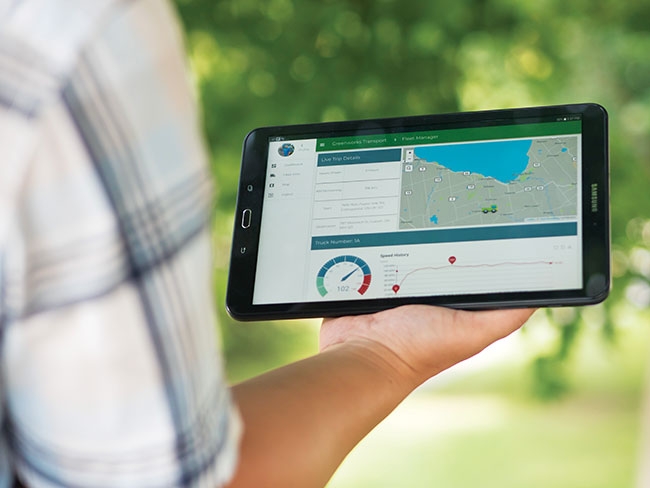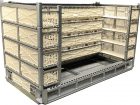
Innovation in poultry transport and handling
By Treena Hein
Features Research WelfareResearchers drive more humane approaches.
 The Transport Genie system uses smart sensors to monitor livestock in real-time during transport. PHOTO CREDIT: Transport Genie
The Transport Genie system uses smart sensors to monitor livestock in real-time during transport. PHOTO CREDIT: Transport GenieAs the Canadian poultry industry continually improves bird welfare, it’s incorporating new research and technologies into transport and handling.
One of Canada’s processing industry leaders, Maple Lodge Farms, has done a large amount of its own research and development on poultry transport and holding facilities. It established a Transport Working Committee in 2014 for this purpose, which included vets, agricultural engineers, ventilation experts, animal behaviourists, transportation specialists and equipment manufacturers.
Since then, the group has evolved into becoming the firm’s permanent Animal Welfare Committee, reports Maple Lodge Farms director of corporate affairs Carol Gardin. “This committee considers a broad range of animal welfare projects and initiatives, including our current transition to modular loading and controlled atmosphere stunning for broiler chickens.”
Maple Lodge Farms has developed several trailer prototypes over the past two years. The design has been refined over time to optimize air flow so that all chickens, no matter where they’re located on the trailer, experience the same environmental conditions. All designs were established using computational fluid dynamics software.
The two mechanical ventilation systems that were trialed (up draft and down draft) were abandoned as they were ineffective. “The challenge…is to overcome the uneven temperature gradients that develop within an enclosed poultry trailer as a result of the birds’ body heat and respiration,” Gardin explains.
“The mechanical ventilation systems not only presented challenges with regards to sanitation and biosecurity, they potentially compounded the gradients that already existed.”
The newest trailer design efficiently moves air around within the trailer, preventing heat and humidity from building up. “During the winter, there is more than ample body heat generated onboard the trailer to keep the birds warm, but the trick is to distribute the heat evenly so that all birds experience the same conditions,” Gardin notes. “Our research demonstrates that the strategic placement of air inlets/outlets can achieve that.”
She adds that having reached a final design, their next step was to automate the system so that air flows are automatically adjusted as temperature/humidity rises or falls.
The design also includes tarps with perforated sections placed strategically along the length of the trailer to work in conjunction with adjustable, perforated boards at the front and back. Other elements include automated roll-up of tarps, a better lighting system, advanced hydraulic-lift roof, in-cab digital environmental display, insulated floors with weather-proof coating (promotes easy cleaning and water run-off) and an advanced biosecurity system.
Gardin explains that, “all of these efforts were timed to align with our implementation of modular loading at the end of October. Currently, the new trailers are being manufactured.
“We will continue to capture data and refine the design, as necessary, to achieve comfortable environmental conditions inside the trailer, across all seasons and weather conditions.”
On the academic front, Trever Crowe, associate member in the Department Animal and Poultry Science at the University of Saskatchewan, with colleague Karen Schwean-Lardner, has been working to accurately define appropriate poultry trailer conditions, especially in cold weather.
Crowe notes that while it’s likely that birds can cope with colder conditions while in transit as long as the trip is relatively short, “we also expect that these appropriate limits will vary with a number of factors: Broilers versus hens versus turkeys or feather cover,” for example. He says once they have a better idea of what birds should and should not be subjected to, the thresholds can be used in a variety of circumstances, including the establishment of science-based codes of practice and set points for actively-ventilated transport trailers.
For its part, Transport Canada updated its Health of Animals Regulations (Humane transportation) in 2016 and will publish amendments in early 2019. The department claims that the amendments will accomplish a variety of goals besides improved welfare, including alignment with international standards and current science, clarification of definitions and removal of vague terms, improvement of enforcement capabilities and removal of obsolete or unnecessary requirements.
Trailer sensors
A patented real-time transport trailer sensing system is now being launched by the Ontario-based creators of Be Seen, Be Safe geo-fencing farm visitor tracking and outbreak biosecurity control system.
Called Transport Genie (TG), its system consists of sensors placed in the trailer that continually relate data on humidity and temperature to transport fleet managers and drivers so they can make the best decisions possible on environmental conditions. Data receivers can set up automated responses, for example, so that conditions are adjusted when they approach a threshold, or track data over time.
The system was trialled at Luckhart Transport in Sebringville, Ont., this year, and presented at both the Ontario Pork Congress in June and the World Poultry Tech Conference in Atlanta, Ga. in November, among other significant meetings.
The development of TG was partly supported through the Accelerating Innovative Research program through the Ontario Ministry of Agriculture, Food and Rural Affairs. The Canadian Animal Health Coalition (CAHC) also helped in the development. CAHC is a non-profit that works to identify farmed animal health and welfare solutions, influence government policy and more, and has created the Canadian Livestock Transport (training) Program.
In the view of CAHC executive director Mark Beaven, TG is revolutionary. “Traditionally, transporters have had the ability to monitor such things as temperature, but it was through the use of data loggers, so it was after the fact,” he notes. “In many cases, this was too late. With TG, transporters will have the opportunity to take corrective measures before any change in variables cause any ill effect towards the livestock being transported.
“And the fact that there are multiple checks and balances as well will allow for greater accountability. Not only the driver will be alerted, but the fleet manager can be alerted to any issues while in transport. All of these capabilities that TG brings to the industry will not only improve the welfare of the livestock and poultry while in transit, but also the quality of the end product. It is for these reasons that the CAHC is so supportive of doing what we can to assist in the development of technologies like TG.”
Beaven predicts that TG will be used in all commodities, but expects that poultry and swine will be the two largest sectors that could benefit from this technology.
New handling systems
One sale has occurred so far in Canada of a new modular poultry handling system from Marel. The firm’s industry marketing manager Roy Driessen says the design of the ATLAS gives maximum attention to bird well-being while considerably increasing efficiency. The system’s SmartStack transportation module increases loading capacity by up to 38 per cent, which means fewer truck movements and fewer CO2 emissions. “At the same time, more space is available per bird and hygiene is up,” Driessen says.
Cargill recently installed a $22 million state-of-the-art Controlled Atmospheric Stunning (CAS) system at its London, Ont., chicken processing facility. The system replaces electric stunning and has been operational since the spring.
The firm notes that while both electric and CAS stunning systems are approved, proven and acceptable for humane poultry harvesting, a growing number of consumers and customers are expressing a desire for CAS systems. Cargill says it was a pioneer in the use of CAS, having installed it at one of its U.S. turkey processing facilities more than a decade ago.
Catching updates
An evaluation of two broiler catching methods was recently published in the journal Animals. As catching and associated handling at catching can lead to stress, injuries and mortality, Norwegian researchers Kittelsen, Granquist, Aunsmo, Oppermann Moe and Tolo investigated the effect of two hands-on broiler catching methods.
One method was broilers being caught by both legs and carried inverted to the drawers, and the other was birds caught under the abdomen and carried in an upright position.
The team took the following measurements: Effects of catching method on crating time; number of birds in the drawers and number on their backs in the drawers; number of wing and leg fractures; and number of birds dead-on-arrival at the slaughterhouse.
Neither method resulted in broken legs, birds on their back in the drawers or broilers dead-on-arrival. The upright catch and carry method provided a lower and more consistent number of birds per drawer. In addition, this method resulted in fewer wing fractures and was also faster.
However, the Canadian national Poultry Handling and Transportation Manual directs broiler catchers to catch birds by the leg. This manual and an associated one-day training session were first produced in 2015 by the Poultry Services Association (PSA) in conjunction with Al Dam, poultry specialist with the Ontario Ministry of Agriculture, Food and Rural Affairs.
PSA is non-profit organization representing those involved in the handling and transportation of poultry in Ontario (about 85 per cent of commercial poultry catching and 90 per cent of live haul by volume).
PSA executive director Susan Fitzgerald says the manual and training were very well-received at the time, and in 2016 PSA teamed up with the Canadian Poultry and Egg Processors Council to expand the content and make both the manual and training applicable in all provinces. “That led to a revised national version of the manual being issued in 2017 along with updated training,” Fitzgerald says. “There have been 971 people take the training.”
The manual directs poultry workers to “gently catch broilers by the legs just above the feet and move them to containers in a way to avoid injuring their legs, joints, or wings.” Fitzgerald says catching broilers as described is considered a humane method of handling and adds that in the pullet section of the manual and also in the end-of-lay section for caged layers birds are to be supported under the breast.
Print this page


